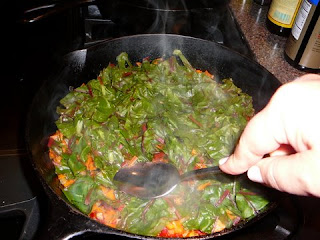I added a little salt and pepper and parmesan cheese to the top of the eggs once they were poached. Clever Husband and Busy Girl loved it. They added some Tamari (wheat-free soy sauce) to theirs for some extra flavor.
 These photos are backwards and I don't have time to rearrange them now, but here what the chard looks like after it's been sauteed. I'm making the indentations for the eggs.
These photos are backwards and I don't have time to rearrange them now, but here what the chard looks like after it's been sauteed. I'm making the indentations for the eggs. As you can see the raw chard below filled the cast iron skillet before it cooked down.
As you can see the raw chard below filled the cast iron skillet before it cooked down. Here's the sauteed onion, garlic, carrots and dried tomatoes which are under the chard. I wasn't sure I'd like this combination with the tomatoes, but that was one of my favorite flavors in this dish. I used Sun-Dried tomatoes in olive oil.
Here's the sauteed onion, garlic, carrots and dried tomatoes which are under the chard. I wasn't sure I'd like this combination with the tomatoes, but that was one of my favorite flavors in this dish. I used Sun-Dried tomatoes in olive oil. Why Grow it in the first place?
Why Grow it in the first place?To be honest we've had some curious looks when we run down the list of the veggies we're growing when it comes to Swiss Chard. Some folks nod and smile and you can tell they're wondering why in the world we'd grow it, or they've never heard of it and don't want to appear ignorant of the lovely plant.  Swiss Chard is in the beet family so the green tops look close to beet greens. The stalks which hold these leaves look like skinny celery or rhubarb stalks in colors ranging from pale green to deep red and even pink and yellow.
Swiss Chard is in the beet family so the green tops look close to beet greens. The stalks which hold these leaves look like skinny celery or rhubarb stalks in colors ranging from pale green to deep red and even pink and yellow.
Swiss chard loaded with nutritious vitamins including vitamins K, A, C and E, plus several B vitamins, magnesium, manganese, potassium, iron and dietary fiber. Calcium is also in these beautiful plants along with cancer-fighting properties. The reason it's called Swiss Chard is because a swiss bontaist named Koch gave it's official scientific name of beta vulgaris. See told you it was in the beet family. That name doesn't conjure up affection toward this plant, but instead I read it "Vulgar Beets." Don't be alarmed! Nothing vulgar about this plant at all.
 Swiss Chard is in the beet family so the green tops look close to beet greens. The stalks which hold these leaves look like skinny celery or rhubarb stalks in colors ranging from pale green to deep red and even pink and yellow.
Swiss Chard is in the beet family so the green tops look close to beet greens. The stalks which hold these leaves look like skinny celery or rhubarb stalks in colors ranging from pale green to deep red and even pink and yellow.Swiss chard loaded with nutritious vitamins including vitamins K, A, C and E, plus several B vitamins, magnesium, manganese, potassium, iron and dietary fiber. Calcium is also in these beautiful plants along with cancer-fighting properties. The reason it's called Swiss Chard is because a swiss bontaist named Koch gave it's official scientific name of beta vulgaris. See told you it was in the beet family. That name doesn't conjure up affection toward this plant, but instead I read it "Vulgar Beets." Don't be alarmed! Nothing vulgar about this plant at all.
Greening up your diet can do nothing but good for your body so planting swiss chard is an easy way to add some healthy greens to your table. We bought "Bright Lights" which is a combo of colors and planted the seeds in late March. We've been harvesting the leaves for the past week and the plants show no signs of stopping. Cut the outside leaves with scissors just like lettuce and it keeps producing from the center of the plant. 

Any takers willing to try adding swiss chard to their menus this week or to their gardens? Try the Eggs in a Nest for a nutritious meatless meal. It fills you up with lots lots good fiber, greens, and veggies, along with the protein in the egg and brown rice.
Here's to brave palates and colorful garden vegetables!
